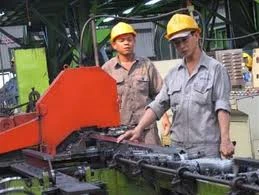
Strong brand name
In 1978, the Huu Lien brand first appeared in the market. At the beginning, Huu Lien was only involved in manufacturing different types of bicycle and motorbike parts such as chains, wheels, and plugs. At that time, Huu Lien was considered one of the few companies to produce these spare parts. Within two years, the production facility at Huu Lien was expanded with more than 100 employees, and thrived in both production and scale. By April 1992, the enterprise was renamed Huu Lien Private Enterprise, and further branched into production of consumer mechanical products, rolled metal, plastic and pipe production, steel products of all kinds, trading, and also became a consignment agent of goods.
By 1999, when steel pipe facilities began to first appear in the country, HLA became the first enterprise to produce steel pipes on an industrial scale. On 20 April 2001, HLA officially began operating under the JSC model with a new name Huu Lien A Chau. From this time on, the main product of HLA became steel pipes, with annual revenue and output accounting for around two third of the total revenue of the factory. HLA steel pipe products included many types, from round steel pipes, oval pipes to D-shaped pipes and square pipes. The thickness of the steel pipes was from 0.7-3.5mm with many different specifications corresponding to the diverse needs of the customers.
At this time, HLA grew in scale and continuously increased capital. Specifically, in 2002 it increased charter capital to VND 30 bn, in 2003 to VND 60 bn, in 2004 to VND 100 bn and in 2006 it had touched VND 140 bn. HLA steel pipes were the main industrial product in Ho Chi Minh City in the period 2001 until 2009.
Turning point
On 30 October 2008, HLA officially listed 19 million shares on HOSE at a price of VND 30,000 per share. Due to listing when the market was not favorable, HLA shares were somewhat affected, even dropping to just VND 10,000 per share. However, during recovery of the stock market in 2009, HLA was at a peak of VND 48,800 per share. During this time HLA liquidity was also very impressive. Millions of shares transferred at each session. Even large organizations such as banks and securities companies were rushing to grab HLA stock and avail the opportunity.
However, the turning point for HLA began in 2009, when the stock was put on alert because the after-tax profit of 2008 showed negative. According to 2008 before-auditing financial statements, the after-tax profit was VND 37 bn, but after auditing, the net loss was VND 19.4 bn, a huge difference of VND 56.4 bn. The reason was the difference in price determination time to calculate the provision for devaluation of goods and raw materials on 31 December 2008 between HLA and the audit firm Ernst & Young. Specifically, in the Consolidated Financial Statements of 2008, HLA made a provision for devaluation of inventories as of 31 December 2008 of VND 22.4 bn. However, the financial statements were audited with the consultation of Ernst & Young, and the provision for inventory was determined at VND 85.8 bn.The time to determine the market value of inventories to calculate the provision for devaluation was at the time Ernst & Young conducted the audit.
Not even equal to cup of iced tea
In fact, the "stumble" in 2008 was just the beginning of the decline of HLA in the following years due to fluctuations in steel prices. In particular, the price of raw materials fluctuated abnormally and irregularly, causing HLA to continuously fall into a situation of "buying high and selling low", which led to heavy losses. Specifically in 2013, the loss was VND 235.7 bn, in 2014 it was VND 475.6 bn, in 2015 it was VND 387.3 bn, and in 2016 it had fallen to VND 416 bn.
Thus, within just four years, accumulated losses of HLA amounted to VND 1,500 bn. In the 2016 financial report, the auditor made a note of doubting the continuity of the company. Accordingly, the auditor emphasized that the equity of the company was negative at VND 970 bn, and liabilities exceeded total assets of the same amount of VND 970 bn. This indicated existence of uncertain elements, which caused doubts about the company's ability to continue to operate.
The situation worsened by 2018, when banks simultaneously announced the seizure of collaterals of land use rights associated with HLA assets due to late payment of debts. Specifically, at the end of the third quarter of 2018, HLA accumulated losses were around VND 1,884 bn, equity was negative at VND 1,395 bn, short-term debt exceeded short-term assets of an amount of VND 1,597 bn, in which, provision expense was VND 527 bn and interest expense was VND 538 bn. In addition, total outstanding loans as overdue payment at banks was at VND 690 bn. These loans were mortgaged by land use rights, ownership of structures on land and other fixed assets.
Bad business results were the main reason for stocks to hit rock bottom. In 2015, HLA was forced to delist on HOSE due to accumulated losses. On 30 September 2014 losses were negative by VND 656.42 bn, exceeding the actual charter capital of VND 344.59 bn. After leaving HOSE, HLA listed again on UPCoM. But this time the comeback was worse when the stock was restricted for trading, with low liquidity, and stock price plummeted to rock bottom to an alarming VND 200 per share.




















